Towards a Preservation–Sustainability Nexus: Applying LCA to Reduce the Environmental Footprint of Modern Built Heritage
Abstract
1. Introduction
2. Materials and Methods
2.1. The Study Area
2.2. The Existing Sustainability-Related Standards and the Methodology Applied
2.2.1. Key Sustainability-Related Negative Aspects Identified for the Study Area
2.2.2. Application of LCA to the Modern Built Heritage Case Study
- Environmental decision making based on scientific methodologies rather than arbitrary estimates;
- Overturning existing, erroneous and unfavorable environmental views of public opinion on various products or activities;
- Evaluating conservation interventions/materials based on environmental criteria;
- Creating a scientific background to demonstrate the need to adopt economic measures;
- Informing citizens about the impact on the environment of products they use and activities they carry;
- Assessment of investment plans related to their impact on the environment.
3. Results
3.1. Goals and Scope
- Stone materials corresponding to 90% of the masonry total volume. The stone used was limestone containing iron oxide admixtures;
- Joint mortars constituted 10% of the total masonry volume. Mortars were clay-lime-based mortars (90% clay and 10% lime);
- Reinforced concrete comprising 13% total steel volume and 87% concrete volume and including 75% aggregates and 25% cement binder [25].
3.1.1. Life Cycle Inventory
3.1.2. Impact Assessment
3.1.3. Interpretation
4. Discussion
5. Conclusions and Recommendations
Author Contributions
Funding
Acknowledgments
Conflicts of Interest
Appendix A
| Planning/Design Commissioning | - | Transport of Products to Building Site | Construction | |
| Users | -Integrated planning procedures -User participation -Stakeholder involvement | - | - | - |
| Neighborhood | -Neighborhood participation -Stakeholder involvement | - | Traffic noise | -Traffic noise -Social standards of the construction processes (safety, neighborhood protection) |
| Society | -Number of urban planning processes (stakeholder dialogues, etc.) | -Social standards/works -Conditions during the extraction and processing of raw materials and during manufacturing -Sourcing of materials -Regional economic and employment laws | Traffic noise through transport routes | -Social standards of the companies involved -Social facilities on the construction site (e.g., toilets) -Stakeholder involvement |
| Use | ||||
| Operation/building related, for the fabric during the usage stage | User and control systems related to data for the operation of the building and its elements during the usage stage | |||
| Users | -Accessibility -Adaptability -Health and comfort -Maintenance -Safety/security | -health and comfort -maintenance -safety/security | ||
| Neighborhood | Loadings in neighborhood | Loadings in neighborhood | ||
| Society | -Infrastructure (public transport) -Social affordability and cost efficiency -Stakeholder involvement | - | ||
| After Use | ||||
| Disassembly | Transport of waste | Disposal | ||
| Users | -Hazardous material -Accidents -Noise -Dust | -noise, traffic, and dust | - | |
References
- Avrami, E. Making Historic Preservation Sustainable. J. Am. Plan. Assoc. 2016. [Google Scholar] [CrossRef]
- Chiotinis, N. The request of sustainability and architecture as cultural paradigm. Manag. Environ. Qual. Int. J. 2006, 17, 593–598. [Google Scholar] [CrossRef]
- Harvey, D. Justice, Nature, and the Geography of Difference; Blackwell Publishers: Cambridge, UK, 1996. [Google Scholar]
- IEA. Energy Efficiency: Buildings. 2019. Available online: https://www.iea.org/topics/energyefficiency/buildings/ (accessed on 11 September 2019).
- Lotteau, M.; Loubet, P.; Pousse, M.; Dufrasnes, E.; Sonnemann, G. Critical review of life cycle assessment (LCA) for the built environment at the neighborhood level. Build. Environ. 2015, 93, 165–178. [Google Scholar] [CrossRef]
- Cole, R.J. Regenerative design and development: Current theory and practice. Build. Res. Inf. 2012, 40, 1–6. [Google Scholar] [CrossRef]
- Mang, N. Toward a Regenerative Psychology of Urban Planning, Saybrook Graduate School and Research Center, San Francisco, CA. 2009. Available online: http://gradworks.umi.com/33/68/3368975.html (accessed on 11 September 2019).
- Mang, P.; Reed, B. Designing from place: A regenerative framework and methodology. Build. Res. Inf. 2011, 40, 23–38. [Google Scholar] [CrossRef]
- Reed, B. Shifting from ‘sustainability’ to regeneration. Build. Res. Inf. 2007, 35, 674–680. [Google Scholar] [CrossRef]
- Mang, P.; Reed, B. Regenerative Development and Design Regenesis Group and Story of Place Institute Chapter 303. In Encyclopedia Sustainability Science and Technology; Springer: New York, NY, USA, 2012. [Google Scholar] [CrossRef]
- Chatzikonstantinou, E.V.; Vatavali, F. Energy Deprivation and the Spatial Transformation of Athens in the Context of the Crisis. In Energie und Soziale Ungleichheit; Springer: Wiesbaden, Germany, 2017. [Google Scholar]
- Kafassis, N. Réhabilitation Durable: Réaménagement de la Zone des Anciens Logements Pour Réfugiés à Athènes, Mémoire de Diplôme; École d’architecture Paris Val de Seine: Paris, France, 2007. [Google Scholar]
- Theofani, C.H. Sustainability of Historic Refuge Complex of Alexandras Avenue. Masters’ Thesis, NTUA, Athina, Greece, 2017. [Google Scholar]
- Atanda, J.O. Developing a social sustainability assessment framework. Sustain. Cities Soc. 2019, 44, 237–252. [Google Scholar] [CrossRef]
- Kyvelou, S.T.; Hetzel, J.; Sinou, M.; Iwamura, K. L’application du Développement Durable au Cadre Bâti Dans L’espace Méditerranéen: La Démarche SD-MED; Presses Universitaires de Limoges: Limoges, France, 2006; ISBN 978-2-84287-425-4. [Google Scholar]
- ISO EN 15643-1:2011. Sustainability of Construction Works—Sustainability Assessment of Buildings—Part 1: General Framework. Available online: https://shop.bsigroup.com/ProductDetail/?pid=000000000030192734 (accessed on 1 November 2019).
- ISO EN15643-2:2011. Sustainability of Construction Works. Assessment of Buildings. Framework for the Assessment of Environmental Performance. Available online: https://shop.bsigroup.com/ProductDetail/?pid=000000000030259777 (accessed on 1 November 2019).
- ISO EN15643-3:2011. Sustainability of Construction Works. Assessment of Buildings. Framework for the Assessment of Social Performance. Available online: https://infostore.saiglobal.com/preview/98698349683.pdf?sku=875206_SAIG_NSAI_NSAI_2080567 (accessed on 1 November).
- ISO EN156431-4:2011. Sustainability of Construction Works. Assessment of Buildings. Framework for the Assessment of Economic Performance. Available online: https://shop.bsigroup.com/ProductDetail/?pid=000000000030186110 (accessed on 1 November 2019).
- ISO EN 15643-5:2017. Sustainability of Construction Works—Sustainability Assessment of Buildings and Civil Engineering Works. Part 5: Framework on Specific Principles and Requirement for Civil Engineering Works. Available online: https://infostore.saiglobal.com/preview/is/en/2017/i.s.en15643-5-2017.pdf?sku=1951532 (accessed on 1 November 2019).
- The National Air Pollution Monitoring Network, Air Quality Data, Ministry of Environment and Energy. Available online: http://www.ypeka.gr/Default.aspx?tabid=492&locale=en-US&language=el-GR (accessed on 18 October 2019).
- Strategic Noise Mapping for agglomerations in Greece, Ministry of Environment and Energy. Available online: http://www.ypeka.gr/Default.aspx?tabid=936&locale=en-US&language=el-GR (accessed on 18 October 2019).
- Rebitzer, G.; Ekvall, T.; Frischknecht, R.; Hunkeler, D.; Norris, G.; Rydberg, T.; Schmidt, W.P.; Suh, S.; Weidema, B.P.; Pennington, D.W. Life cycle assessment part 1: Framework, goal and scope definition, inventory analysis, and applications. Environ. Int. 2004, 30, 701–720. [Google Scholar] [CrossRef] [PubMed]
- Gabi ts (v.8.7.0.18). Available online: http://www.gabi-software.com/international/index/ (accessed on 18 October 2019).
- Bakolas, A. Criteria and Characterization of Historic Mortars. Ph.D. Thesis, NTUA, Athina, Greece, 2002. [Google Scholar]
- Guinée, J.B.; Gorrée, M.; Heijungs, R.; Huppes, G.; Kleijn, R.; de Koning, A.; van Oers, L.; Wegener Sleeswijk, A.; Suh, S.; Udo de Haes, H.A.; et al. Handbook on Life Cycle Assessment; Operational Guide to the ISO Standards. I: LCA in Perspective. IIa: Guide. IIb: Operational Annex. III: Scientific background; Kluwer Academic Publishers: Dordrecht, The Netherlands, 2002; p. 692. ISBN 1-4020-0228-9. [Google Scholar]
- Huijbregts, M.A.J.; Steinmann, Z.J.N.; Elshout, P.M.F.; Stam, G.; Verones, F.; Vieira, M.D.M.; Hollander, A.; Van Zelm, R. ReCiPe2016: A Harmonized Life Cycle Impact Assessment Method at Midpoint and Endpoint Level; RIVM Report 2016-0104; Rijksinstituut voor Volksgezondheid en Milieu RIVM: Bilthoven, The Netherlands, 2016. [Google Scholar]
- Rosenbaum, R.K.; Bachmann, T.K.; Gold, L.S.; Huijbregts, M.A.J.; Jolliet, O.; Juraske, R.; Koehler, A.; Larsen, H.F.; MacLeod, M.; Margni, M.; et al. USEtox—The UNEP/SETAC-consensus model: Recommended characterisation factors for human toxicity and freshwater ecotoxicity in Life Cycle Impact Assessment. Int. J. Life Cycle Assess. 2008, 13, 532–546. [Google Scholar] [CrossRef]
- Van den Heede, P.; De Belie, N. Environmental impact and life cycle assessment (LCA) of traditional and ‘green’ concretes: Literature review and theoretical calculations. Cement Concr. Compos. 2012, 34, 431–442. [Google Scholar] [CrossRef]
- “Saving Energy at Home” (Eksikonomo kat’oikon) Program. Available online: https://exoikonomisi.ypen.gr (accessed on 18 October 2019).
- UCLG. United Cities and Local Governments, Culture, Fourth Pillar of Sustainable Development. 2010. Available online: http://www.agenda21culture.net/sites/default/files/files/documents/en/zz_culture4pillarsd_eng.pdf (accessed on 11 September 2019).
- Athanasiadou, E. Historic Gardens and Parks Worldwide and in Greece: Principles of Acknowledgement, Conservation, Restoration and Management. Heritage 2019, 2, 2678–2690. [Google Scholar] [CrossRef]
- Kyvelou, S.; Papadopoulos, T. Exploring a South-European Eco-Neighborhood Model: Planning Forms, Constraints of Implementation and Emerging Resilience Practices. Int. J. Sustain. Dev. 2011, 14, 77–94. [Google Scholar] [CrossRef]
- Sinou, M.; Kyvelou, S. Present and future of building performance assessment tools. Manag. Environ. Qual. Int. J. 2006, 17, 570–586. [Google Scholar] [CrossRef]
- Baggio, M.; Tinterri, C.; Dalla Mora, T.; Righi, A.; Peron, F.; Romagnoni, P. Sustainability of a historical building renovation design through the application of LEED rating system. Energy Procedia 2017, 113, 382–389. [Google Scholar] [CrossRef]
- Balson, K.; Summerson, G.; Thorne, A. Briefing Paper, Sustainable Refurbishment of Heritage Buildings, How BREEAM Helps to Deliver, BRE. 2014. Available online: https://tools.breeam.com/filelibrary/Brochures/Heritage-Sustainable-Refurbishment-v2.pdf (accessed on 11 September 2019).
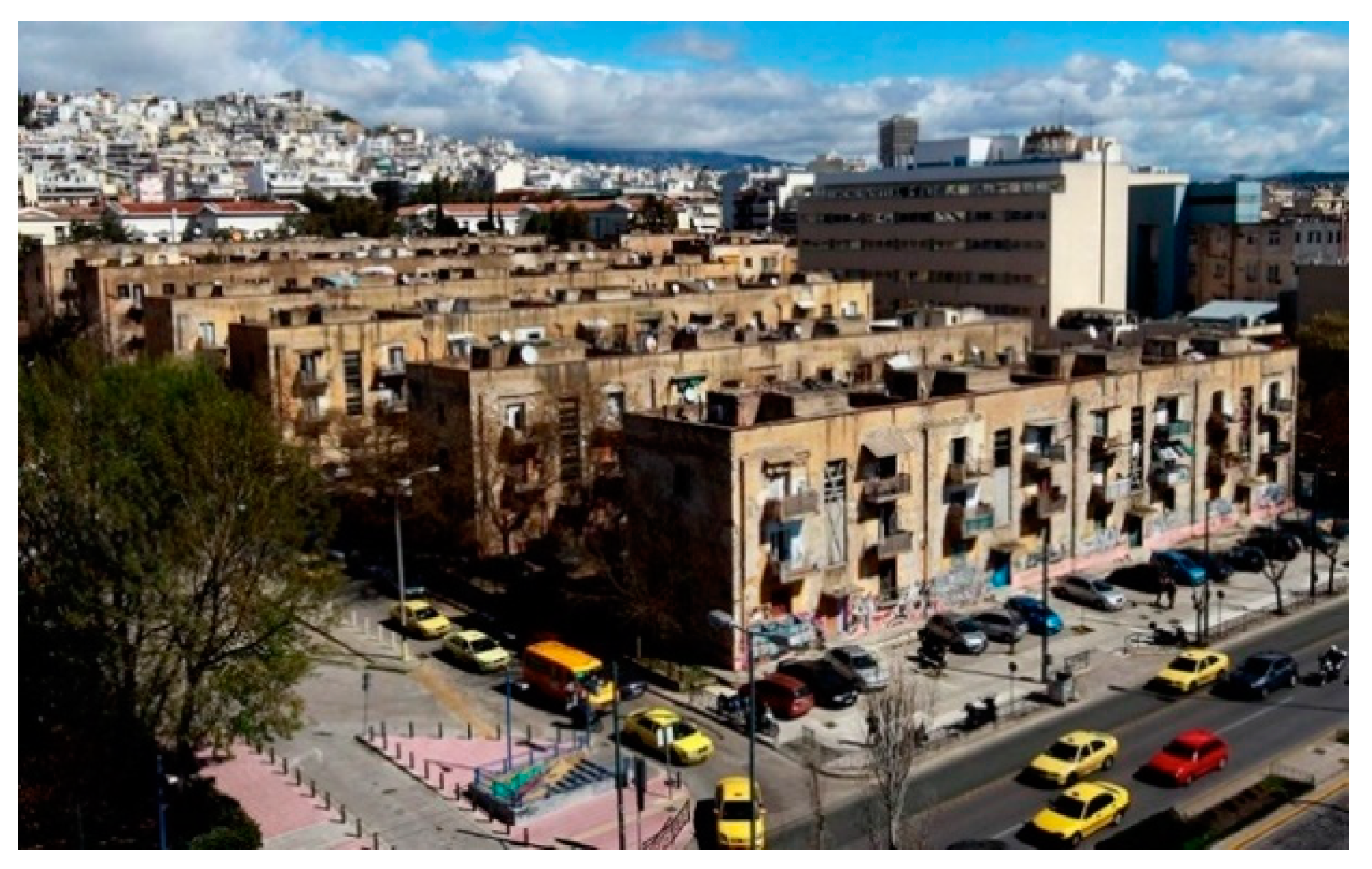
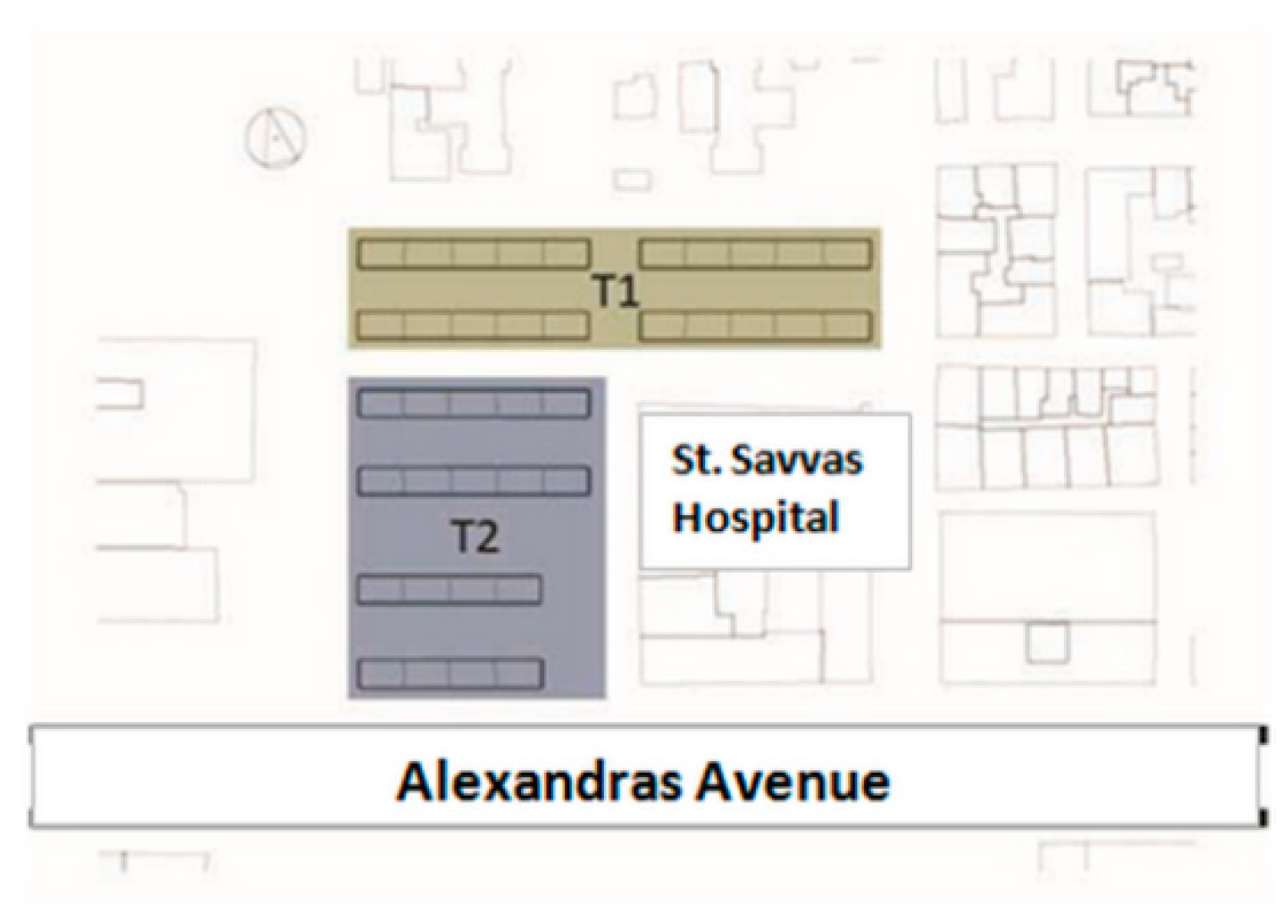

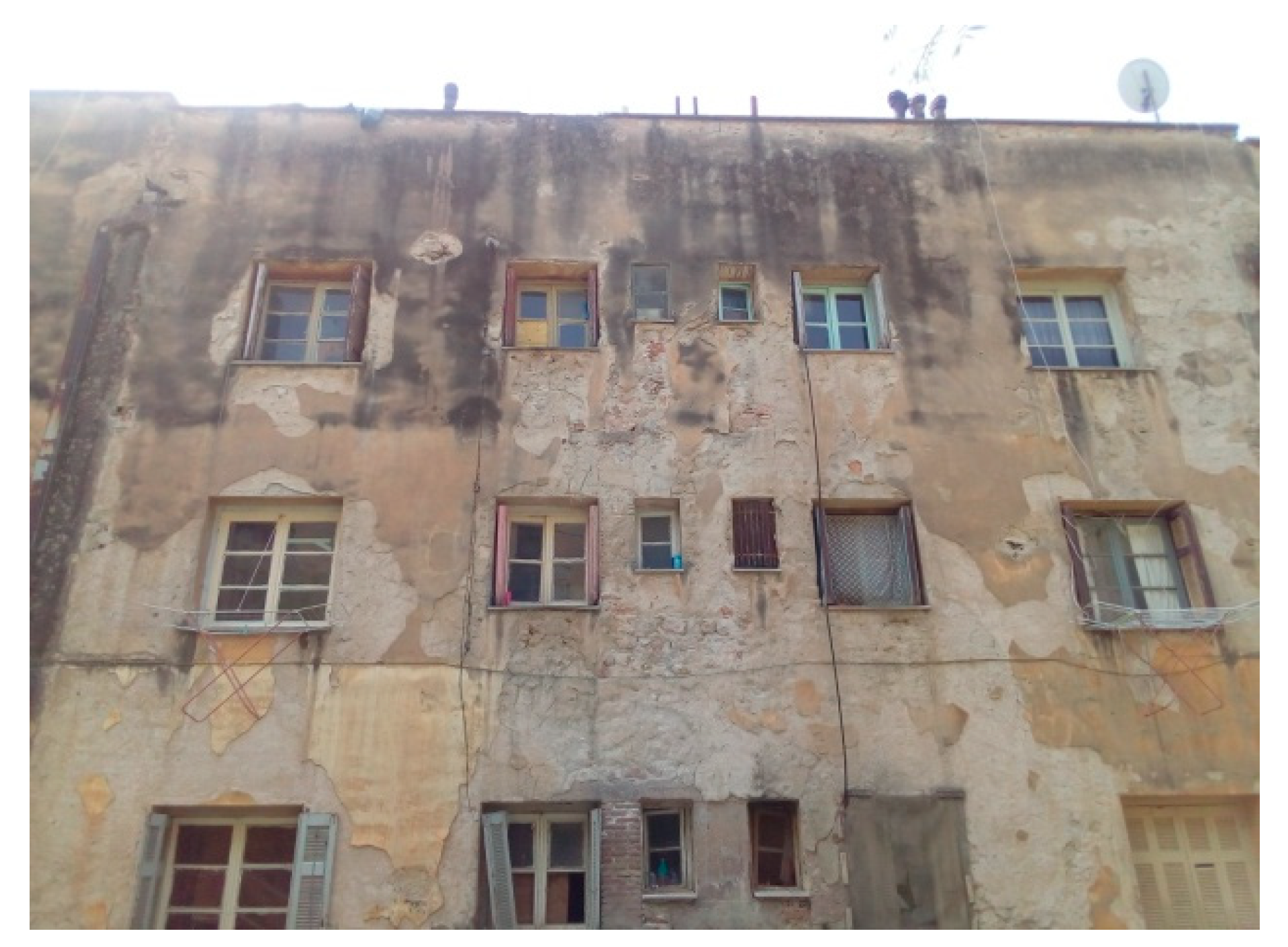
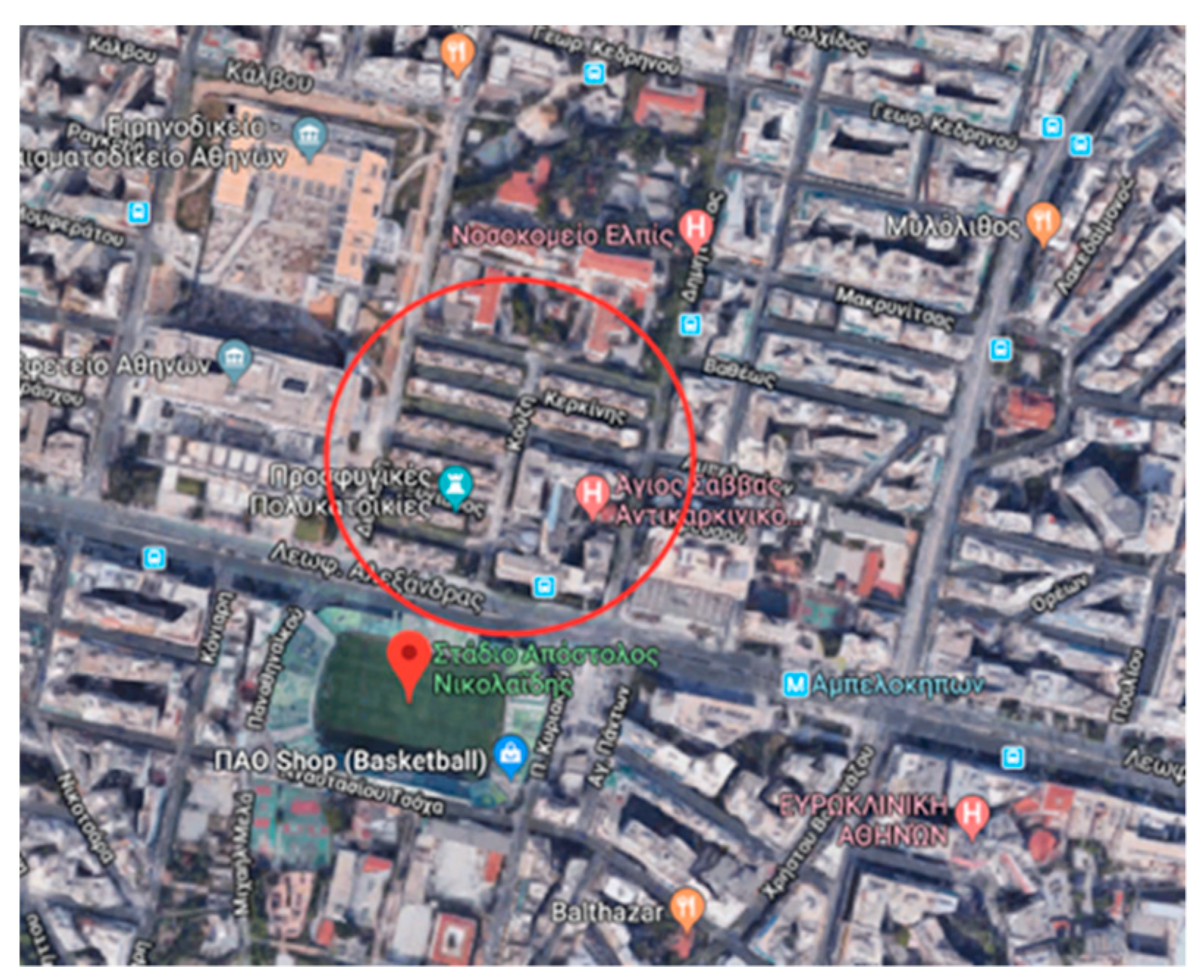
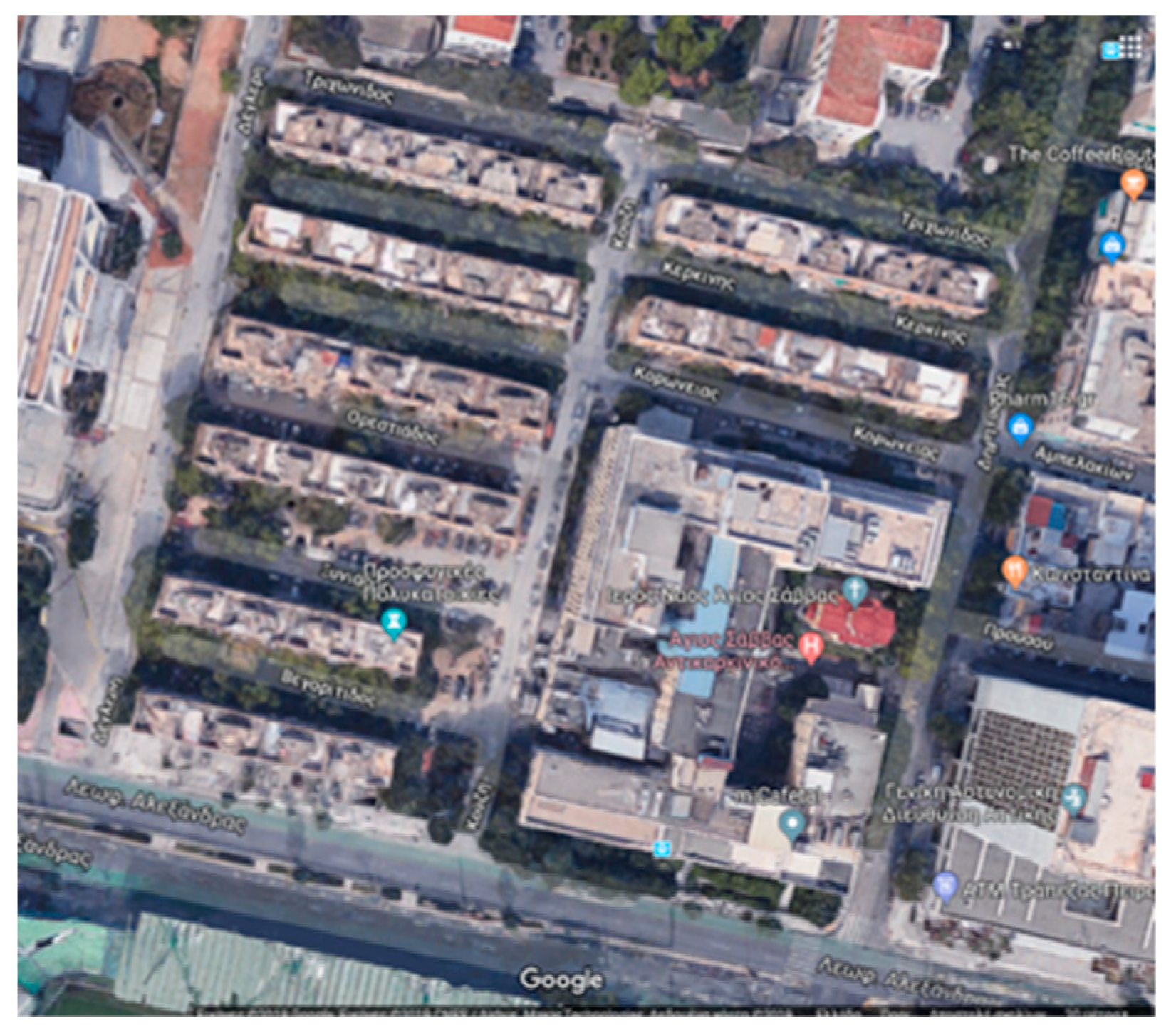




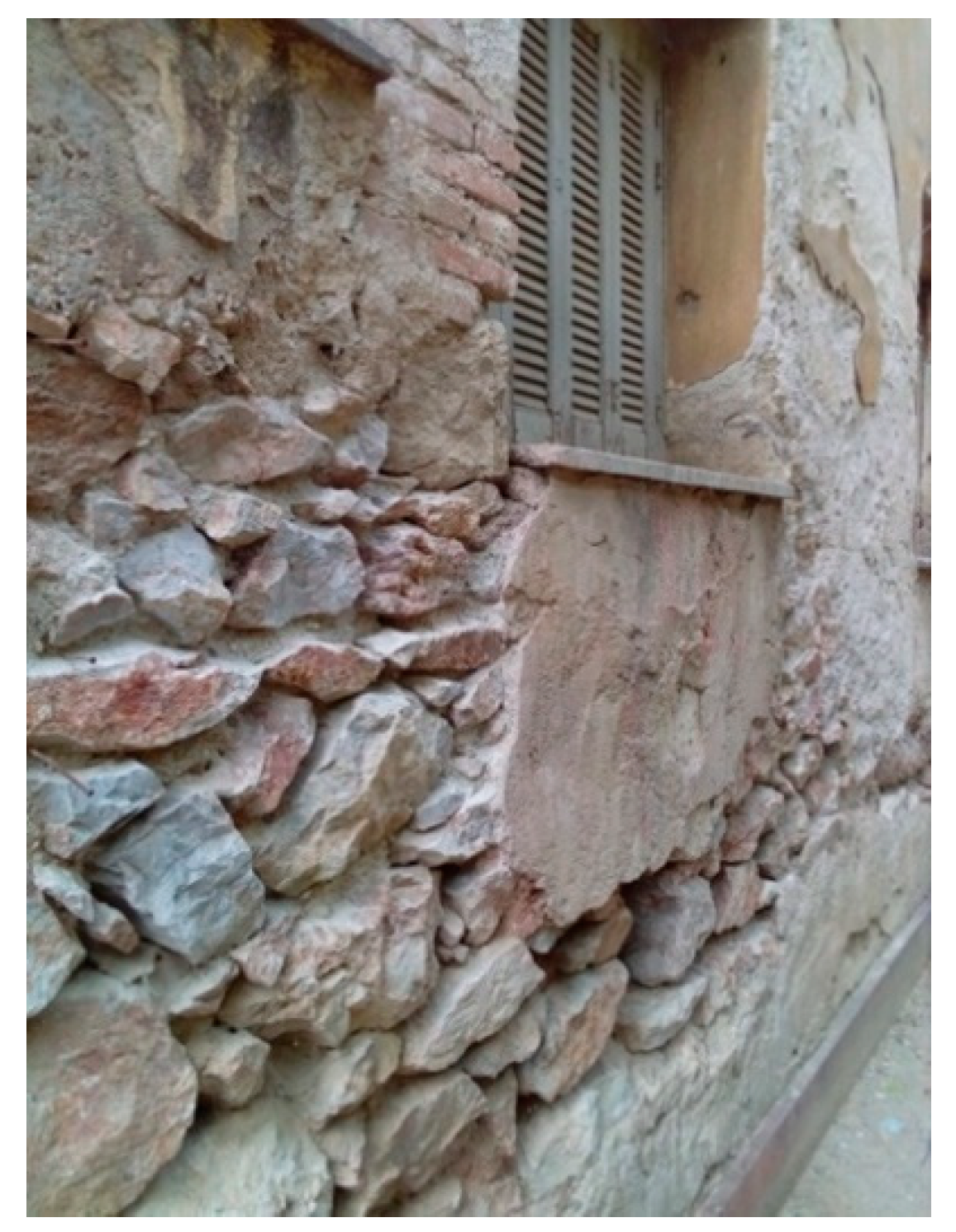
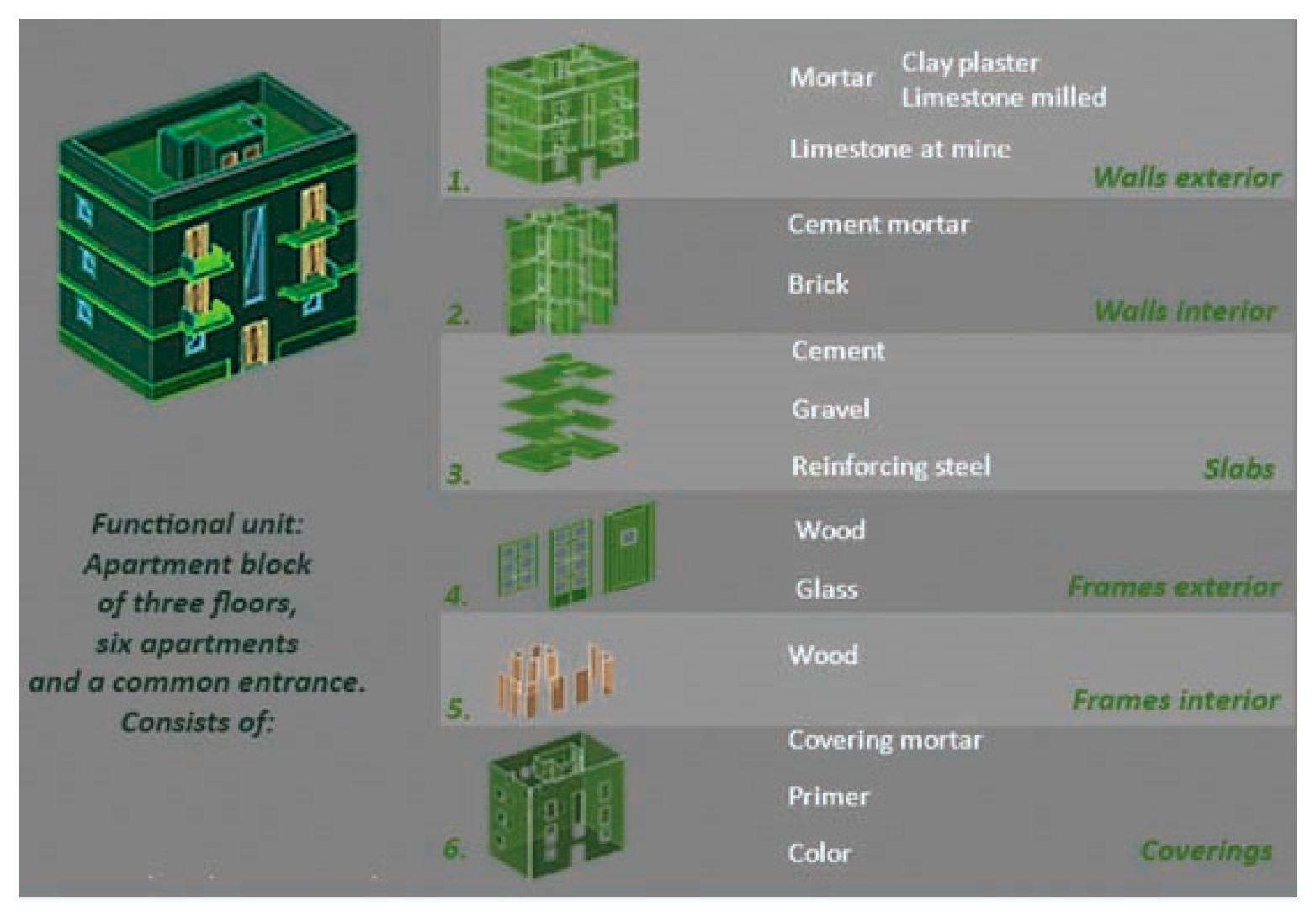
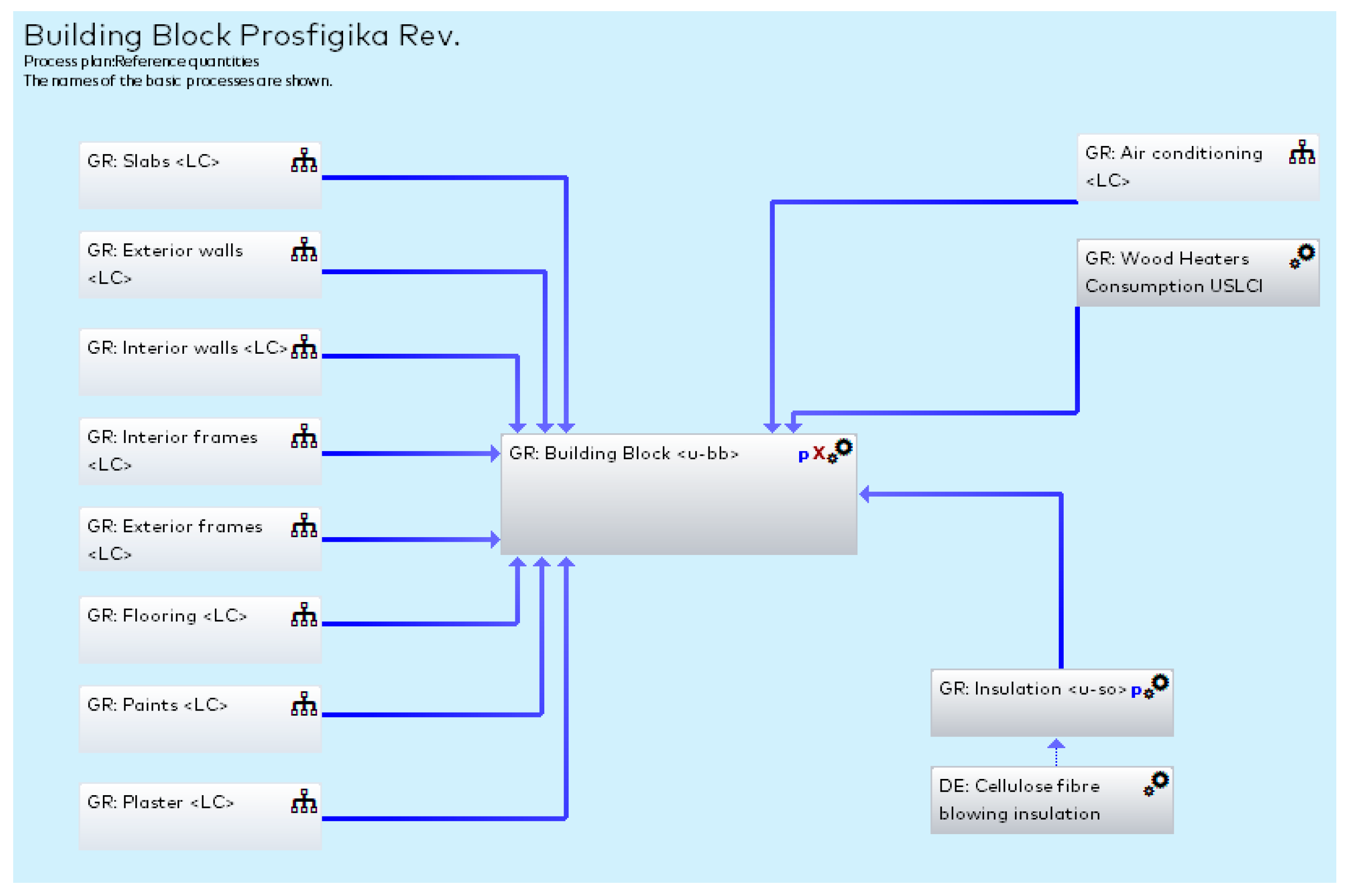
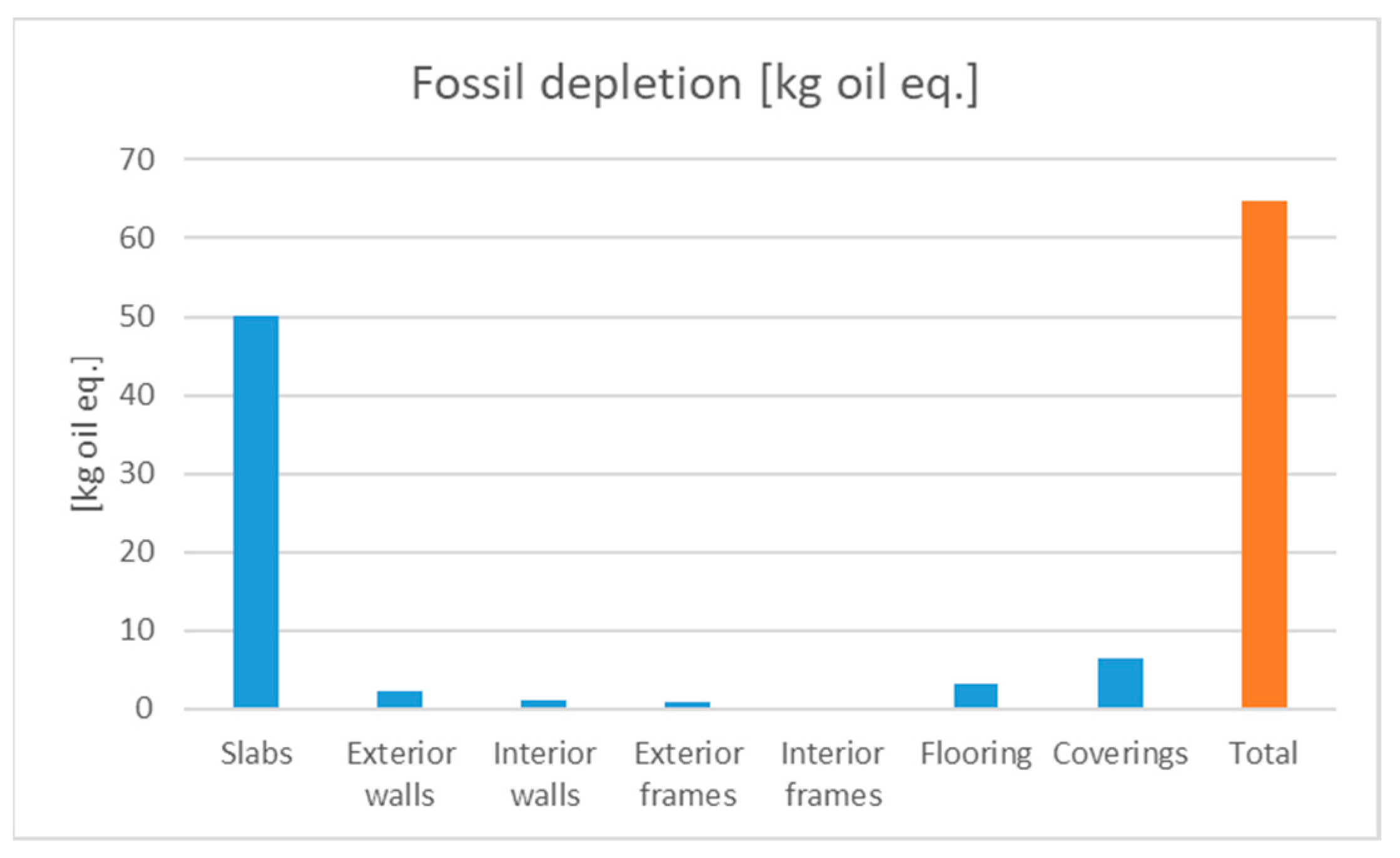

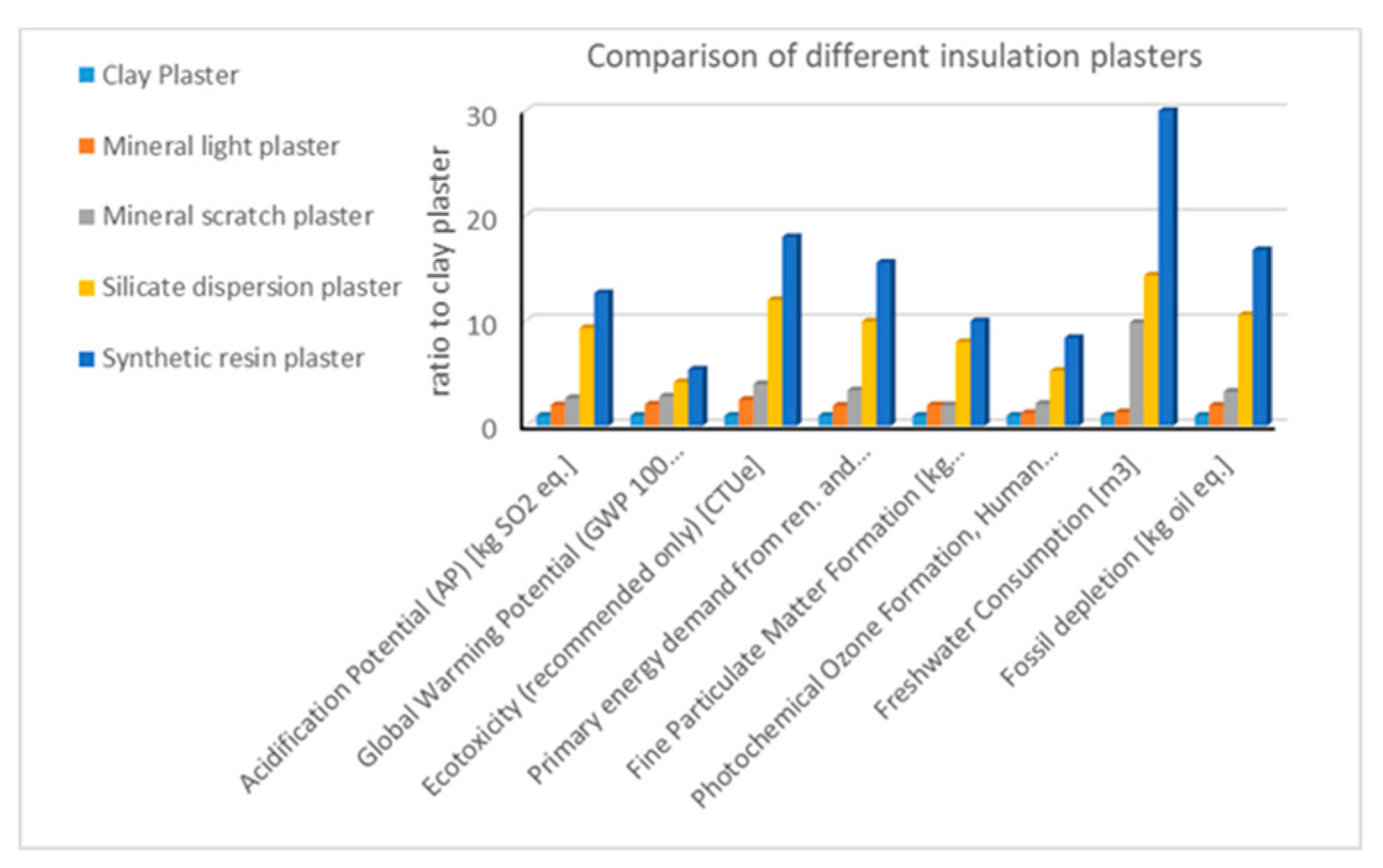
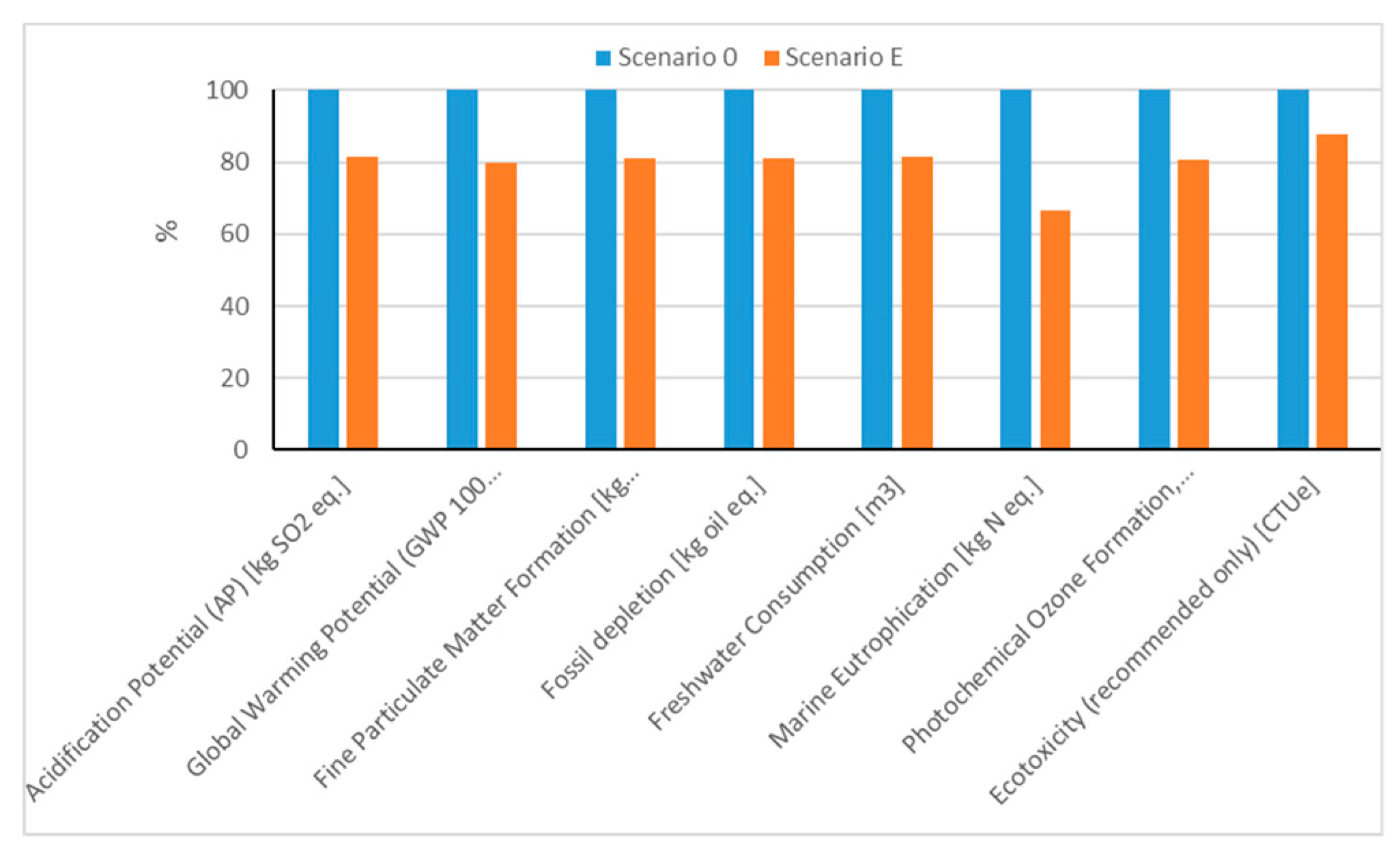

| Building Component and Material | Lifespan (Months) | Unit | Value | Density (kg/m3) | Volume (m3) | Unit/Month |
|---|---|---|---|---|---|---|
| Exterior walls | ||||||
| Clay Plaster | 1200 | kg | 48,000 | 1600 | 30 | 40.00 |
| Limestone, gravel (grain size 16/32) (EN 15804 A1-A3) | 1200 | kg | 418,500 | 1550 | 270 | 348.75 |
| Slabs | ||||||
| Cement (CEM I 32.5) (EN 15804 A1-A3) | 1200 | kg | 94,800 | 1500 | 63.2 | 79.00 |
| Gravel 2/32 | 1200 | kg | 284,490 | 1500 | 189.66 | 237.08 |
| Reinforced steel (wire) (EN 15804 A1-A3) | 1200 | kg | 283,500 | 7500 | 37.8 | 236.25 |
| Interior walls | ||||||
| Bricks vertically perforated (EN 15804 A1-A3) | 1200 | kg | 33,800 | 2000 | 16.9 | 28.17 |
| Normal mortar (A1-A3) | 1200 | kg | 8960 | 1600 | 5.6 | 7.47 |
| Exterior frames | ||||||
| Timber pine (12% moisture; 10.7% H2O content) (EN 15804 A1-A3) | 600 | kg | 2175 | 750 | 2.9 | 3.63 |
| Window glass | 600 | kg | 1250 | 2500 | 0.5 | 2.08 |
| Interior frames | ||||||
| Timber pine (12% moisture; 10.7% H2O content) (EN 15804 A1-A3) | 600 | kg | 2580 | 750 | 3.44 | 4.30 |
| Flooring | ||||||
| Tile adhesive (EN 15804 A1-A3) | 600 | kg | 3s90 | 1500 | 0.26 | 0.65 |
| Stoneware tiles, glazed (EN 15804 A1-A3) | 300 | kg | 1800 | 2000 | 0.9 | 6.00 |
| Laminate flooring DPL (Mix)-Egger (A1-A3) | 300 | m2 | 317 | - | 6.34 | 1.06 |
| Coverings | ||||||
| Insulation system | 300 | m3 | 32.86 | |||
| Paint emulsion (building, exterior, white) (A5) | 120 | kg | 358.4 | 1400 | 0.256 | 2.99 |
| Insulation System | Density [kg/m3] |
|---|---|
| Clay plaster (current state) | 1600 |
| Lightweight plaster (lime-cement) | 1350 |
| Reinforcement (mineral) | 1450 |
| Silicate dispersion plaster | 1600 |
| Synthetic resin plaster (EN15804 A1-A3) | 1600 |
| Air conditioning | ||
| 5.3 kW (18,000 Btu), 8 h/day, 31 days, six apartments | kWh | 7850 |
| Wood heating | ||
| 7.5kg wood/d (5.5 h/d), 31 days, six apartments | kg | 1395 |
| KWh | 7521.1 |
| Category | Suggested Model | Unit of Measurement |
|---|---|---|
| Acidification Potential | CML [Jan. 2016] [26] | kg SO2-eq |
| Global Warming Potential (GWP, 100 years) | CML [Jan. 2016] | kg CO2-eq |
| Ozone Layer Depletion Potential (ODP, steady state) | CML [Jan. 2016] | kg R11eq |
| Human Toxicity | USEtox [27] | CTUh |
| Ecotoxicity | USEtox | CTUe |
| Freshwater Eutrophication | ReCiPe [28] | kg Peq |
| Marine Eutrophication | ReCiPe | kg Neq |
| Particulate Matter | ReCiPe | kg PM2.5-eq |
| Photochemical Ozone Formation | ReCiPe | kg NMVOC-eq |
| Fresh Water Consumption | ReCiPe | m3 |
| Fossil Depletion | ReCiPe | kg oileq |
| Scenario | Insulation | Thermal Insulation | Comment |
| 0 | Clay Plaster | No | Initial situation |
| A | Mineral light plaster | No | No indication of energy saving |
| B | Mineral scratch plaster | No | No indication of energy saving |
| C | Silicate dispersion plaster | No | No indication of energy saving |
| D | Synthetic resin plaster | No | No indication of energy saving |
| E | Mineral light plaster | Cellulose fiber | 20% energy saving |
© 2019 by the authors. Licensee MDPI, Basel, Switzerland. This article is an open access article distributed under the terms and conditions of the Creative Commons Attribution (CC BY) license (http://creativecommons.org/licenses/by/4.0/).
Share and Cite
Karoglou, M.; Kyvelou, S.S.; Boukouvalas, C.; Theofani, C.; Bakolas, A.; Krokida, M.; Moropoulou, A. Towards a Preservation–Sustainability Nexus: Applying LCA to Reduce the Environmental Footprint of Modern Built Heritage. Sustainability 2019, 11, 6147. https://doi.org/10.3390/su11216147
Karoglou M, Kyvelou SS, Boukouvalas C, Theofani C, Bakolas A, Krokida M, Moropoulou A. Towards a Preservation–Sustainability Nexus: Applying LCA to Reduce the Environmental Footprint of Modern Built Heritage. Sustainability. 2019; 11(21):6147. https://doi.org/10.3390/su11216147
Chicago/Turabian StyleKaroglou, Maria, Stella Sofia Kyvelou, Christos Boukouvalas, Chryssa Theofani, Asterios Bakolas, Magdalini Krokida, and Antonia Moropoulou. 2019. "Towards a Preservation–Sustainability Nexus: Applying LCA to Reduce the Environmental Footprint of Modern Built Heritage" Sustainability 11, no. 21: 6147. https://doi.org/10.3390/su11216147
APA StyleKaroglou, M., Kyvelou, S. S., Boukouvalas, C., Theofani, C., Bakolas, A., Krokida, M., & Moropoulou, A. (2019). Towards a Preservation–Sustainability Nexus: Applying LCA to Reduce the Environmental Footprint of Modern Built Heritage. Sustainability, 11(21), 6147. https://doi.org/10.3390/su11216147









